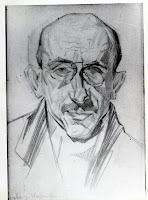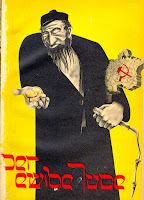Emil Orlik (1877-1932)
Charlotte Rollius (around 1885- ?)
Georgia O'Keeffe (1887-1986)
Alfred Steiglitz (1864-1946)
Joseph (Jo) Steiner (1877-1935)
Julius (Gulya) Steiner (1878-1940)
Senta Söneland (1882-1934)
Egon Friedell (1878-1938)
Today I invite readers to follow my stream of consciousness starting with Emil Orlik. He appeared in before posting and, his influence great, he appeared in many postings before.
Charlotte Rollius (around 1885- ?)
Georgia O'Keeffe (1887-1986)
Alfred Steiglitz (1864-1946)
Joseph (Jo) Steiner (1877-1935)
Julius (Gulya) Steiner (1878-1940)
Senta Söneland (1882-1934)
Egon Friedell (1878-1938)
Today I invite readers to follow my stream of consciousness starting with Emil Orlik. He appeared in before posting and, his influence great, he appeared in many postings before.
The starting point was: search Google for Emil Orliks still-life works and finding this "Bouquet" against a Japanese background:
and a companion painting based on the same idea (roman-antique background) flowers and a strange choise for back ground, perhaps wall decorations.
Any way: recognizing the Calla Lilies in the centre of Orliks painting brought me once again to Oriks student Charlotte Rollius (or Rollins ?) appearing both in before posting) and her Lily painting very much in the style of her teacher Orlik.
The Calla Lily brought me to Georgia O'Keeffe: who married Berlin/New York photographer Alfred Stieglitz. She would become very famous with her very large flower paintings. One of her personal paintings (one of many Calla Lily paintings by her hand) fetched 9.000.000 $ in auction.
It is said the Calla Lily personifies the eccentric artist: strong and independent. The hidden erotic symbolism is obvious. Georgia O'Keeffe was bisexual.
It is said the Calla Lily personifies the eccentric artist: strong and independent. The hidden erotic symbolism is obvious. Georgia O'Keeffe was bisexual.
And then, surfing, in a remote corner of the Internet I stumbled over this auction picture of a portrait by Orlik. Orlik the painter, the printmaker and great portrait artist. A drawing at first glance much like a caricature. But speaking from 2015 that is unfair.
The lady in question, Senta Söneland, was drawn from life. Including her "Class II/division 1 maxillary protrusion": not orthodontically corrected. A century later it is found "necessary" to correct this God-given facial (skeletal) feature in almost every western youngster when reaching puberty. The horses smile regarded un-aesthetical and undesirable by parents and by society. And inferior to the universally accepted "normal and harmonic" and look-alike magazine advertisement Class-I smile, today the preferred standard. Something to think about. Paying the hand of the orthodontist instead of accepting the hand of God (I'm not religious, and a Class II/1 is not an illness: it's big business).
Senta (Gerda) Söneland: posters by Jo Steiner.
What Gerda (Senta) Söneland thought of her nowadays "undesirable" but full and charismatic mouthful of teeth I do not know. She was a popular German film and theatre actress and cabaret performer and had a successful show in the Berlin Kurfürstendamm theater-world around 1910. She also was active in the women's liberation movement speaking and fighting in public for the right for women to vote.
Senta Söneland committed suicide shortly after becoming a widow in 1934. Which brought me to Joseph (Jo) Steiner a "Plakkatkünstler" (poster-artist) and his brother Julius (Gulya)
Selfportrait and his brother Julius by Jo Steiner.
His fabulous posters show the Berlin theater performers of the time (1910-ish) and give a nice picture of the Berlin theatre world and its characters. The poster for the "50 Wilde Togoweiber" (50 wild Togo women + men and children) my favorite. In our politically correct times an unthinkable show touring succesfully Europe in the early 1910's and even more unthinkable poster! Free entree, but at home Catholic and other Christians hypocritically saved aluminium chocolate-bar wrappers for the "Christian Mission" trying to convert these poor wild souls (encouraged and still in practice in the 1960's !)
 Finally Jo Steiner brought me to philosopher, journalist, theatre performer and critic Egon Friedell (read this great Wiki article about Friedell) whom's Jewish features were innocently caricatured by Jo Steiner in Jewish self-mockery. In times being Jewish obviously wasn't considered a problem.
Finally Jo Steiner brought me to philosopher, journalist, theatre performer and critic Egon Friedell (read this great Wiki article about Friedell) whom's Jewish features were innocently caricatured by Jo Steiner in Jewish self-mockery. In times being Jewish obviously wasn't considered a problem. Two decades later Nazi propaganda would use the force of caricature for a dark and sinister reason. Friedell, on his arrest committed suicide by jumping from a window in Vienna in 1938.
"The worst prejudice we acquire during our youth is the idea that life is serious. Children have the right instincts: they know that life is not serious, and treat it as a game.." (Egon Friedell)
-----------------------
All pictures borrowed freely from the Internet for friendly, educational and non commercial use only.





















































